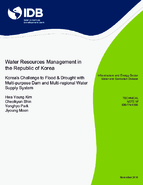Water Resources Management in the Republic of Korea: Korea’s Challenge to Flood & Drought with Multi-purpose Dam and Multi-regional Water Supply System
Date
Nov 2018
The Republic of Korea (ROK, South Korea) boasts a 5,000-year history. However, it is better known for recovering from the complete destruction caused by the Korean War (1950-1953) and for accomplishing ‘the Miracle of Han River’. In 2010, South Korea joined an OECD member nation to provide aid. In doing so, it became the only country that used to receive assistance from other countries to now provide aid to other countries. Since the Korean War, South Korea has constructed various social infrastructures to recover from the aftermath of the war. Construction of multi-purpose dams was selected as one of the most important infrastructures. That decision was prescient. Flood prevention and stable water supply by multi-purpose dams have powered incredible economic growth. This technical note was prepared to provide the countries in Latin America and the Caribbean (LAC) region with insight into ROK’s water-related policies and technologies. Although the ROK’s economic and political situations are surely different from those of the LAC countries, the experiences of Korea can be a good source of insight for LAC countries to find different ways to overcome their own challenges. In this technical note, Chapter 1 outlines the characteristics of South Korean water resources, including an imbalance of rainfall and steep terrain. Chapter 2 presents Integrated Water Resources Management (IWRM). The measure for floods and droughts is explained in this chapter. The water infrastructures are introduced: multi-purpose dams; multi-regional water supply systems, and industrial waterworks. Operation policy and decision-making procedures are also explained in Chapter 2. Chapter 3 explains stable water supply systems. Multi-regional water supply systems and Industrial waterworks could be characterized by the state-run waterworks, which means that the government can solve some regional water resources imbalance problems. Also, non-revenue water reduction technology is explained. The topics of smart technology for adapting to climate change are reviewed in Chapter 4. This chapter introduces important operation centers, such as the Integrated Water Resources Operations Center for multi-purpose dams and hydropower plants. Moreover, the specific technologies needed for smart water resources management are briefly introduced in Appendices. The technologies were developed by Korea Water Resources Corporation (K-water), which is a policy implementation entity owned by the Korean government and is responsible for implementing and managing the water policy. Since 1967, K-water has been in charge of water resources management throughout the country, and plans, constructs, operates, and manages multi-purpose dams, multi-regional water supply systems, and hydropower plants.



